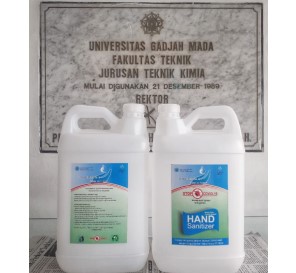
The Chemical Engineering Department, Faculty of Engineering, UGM produces and distributes hand sanitizers and disinfectants in order to support COVID-19 prevention and control. Hand Sanitizer and disinfectant made based on ethanol and hydrogen peroxide. The products then distributed free of charge to hospitals, health centers, clinics, schools, houses of worship, and communities.
Dr. Agus Prasetya and Dr. Himawan Tri Bayu Murti Petrus at the Energy Conservation and Pollution Prevention Laboratory, Department of Chemical Engineering, FT UGM are persons who initiated the manufacturing activity of the hand sanitizer. They initially began to produce hand sanitizers on a small scale for the needs of students, staff, and the community around the campus.
Along with the needs of hospitals, health centers, and other health facilities, the Department of Chemical Engineering, FT UGM, then increases the production of hand sanitizers. Likewise, there is an increasing number of volunteers involved. It also involves more lecturers, students, laboratory assistants, and students.
“Even so, the arrangements in production and distribution still concern to safety rules according to the COVID-19 protocol. At present more than 1,100 L of ethanol-based hand sanitizers have been distributed to all regencies/cities in Yogyakarta, Klaten, and Solo since the beginning of March 2020,” said Agus Prasetya, at the UGM Campus on Monday (4/13).
Himawan explained that in producing this hand sanitizer production, quality control is imposed on raw materials and products. The raw material is analyzed first with gas chromatography to determine its composition and ensure there is no hazardous material in it.
“Some of the raw materials purchased were returned to the seller because they contain high levels of methanol. The hand sanitizer that we produce only contains 70 percent ethanol, 0.125 percent hydrogen peroxide, 1.45 percent glycerol, and the rest is water,” he explained.
Dr. Teguh Ariyanto added that besides the hand sanitizer, the Department of Chemical Engineering, UGM UGM, together with UGM’s Disaster Response Unit (DERU), also distributed hydrogen peroxide-based disinfectants. This disinfectant is used to clean surfaces (floors, chairs, door handles, etc.) from bacteria and viruses.
The distribution of disinfectants is mainly for locations that are prone to be visited by many people, such as hospitals, health facilities (health facilities), and public service agencies that constrained to remain open during the “Work from Home” (WfH) period.
As the coordinator of the Volunteer Team of the Chemical Engineering Department, UGM explained that he chose hydrogen peroxide as one of the materials because, in its use, this material left a safe and non-corrosive residue (only in the form of water and oxygen). s This is different when compared to chlorine-based disinfectants.
There are two product variants. Those are the product with a final dilution of 7.5 percent and 1.4 percent stabilized hydrogen peroxide. Products with a concentration of 7.5 percent are referred to for use in hospitals / puskesmas, while products with a density of 1.4 percent are for areas of public service and community or community.
“Currently, we have distributed 500 L of products. We certainly thank many parties such as volunteers, donors, UGM Faculty of Engineering, FT UGM Chemical Engineering Alumni Foundation, PT Peroxide Indonesia Pratama, PT Enero, PT Indoacidatama, UGM Disaster Response Unit (DERU) and all those who have assisted in the making and distribution of these two products,” he said.
Author: Agung Nugroho
Translator: Natasa A

